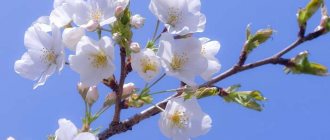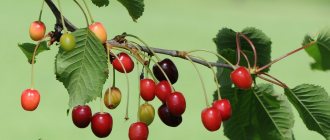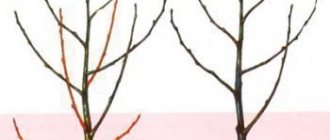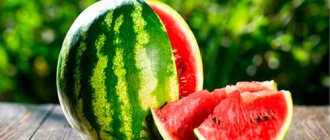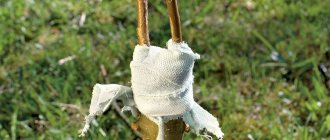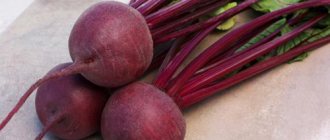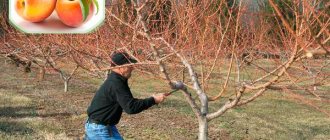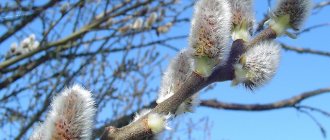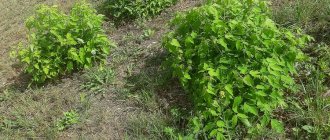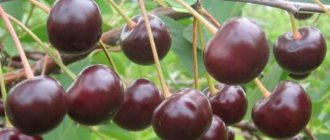Sweet cherries and cherries have similar fruits, but differ in taste and biochemical composition. Sweet cherries are more suitable for fresh consumption, as they have a sweet taste without sourness, but an unsaturated aroma. Cherries are used mainly for processing due to their rich aroma and noticeable sourness, which covers the sweetness. If it is not difficult to distinguish the fruits by taste, then inexperienced gardeners may have problems identifying them by external signs, since it is extremely difficult to distinguish large cherries from sweet cherries. Let us consider in detail how to distinguish berries from each other based on fruits and trees.
Biological affiliation
From a botanical point of view, both cherries and sweet cherries can be called relatives, since both trees belong to the Plum genus and are called in Latin by the same word - Cerasus. Their partial similarity becomes clear, but a number of differences still exist. Determining which tree is a cherry and which is a sweet cherry is actually not difficult; it is enough to have basic knowledge and be able to evaluate a garden plant according to several criteria:
- dimensions;
- shape of leaves and crown;
- the appearance of the fruits themselves;
- growing regions;
- fruiting dates;
- resistance to various diseases;
- the nature of adaptation to certain climatic conditions.
Sometimes it is enough to simply examine a tree and evaluate its external features, including its fruits, in order to understand what exactly is growing on your site if, for example, the garden was not planted by you. You can also use this knowledge when choosing fruits at the market or in a store - this way you will be sure of what exactly the seller is offering you.
Determining the “health” of a seedling
When choosing a seedling, pay attention to the condition of the roots and above-ground parts. The roots should be moist, without growths, the above-ground part should also be free of growths, damage and broken shoots
In order to check whether the roots and shoots are dry, you need to bend a small root into a ring. It should curl up without crunching and feel “alive” to the touch - moist, whitish-green in color. Examine the shoots, also try to bend them - living ones bend well and do not crunch, and the bark on the bend gathers into an “accordion”, but does not peel off.
If the shoots crack even when slightly bent, and the bark peels off in shreds, then most likely they are overdried. This type of planting material is not worth buying.
And, of course, pay attention to the presence of leaves: according to GOST standards for planting material for cherries and cherries, there should be no leaves on the seedling - keep this in mind
Description of trees
The main difference between cherries and sweet cherries is that the first can have both the form of a tree and the form of a bush, while the second is exclusively a tree.
The height of the cherry tree is much higher than the cherry tree, it reaches up to 10 m. Its trunk is quite strong and even, the side branches are arranged in a tiered order, and the roots are located exclusively in the horizontal direction. Cherry trees are characterized by a red-brown bark color in the first years of life, but as they mature, the wood gradually changes its color and acquires a silvery tint with peeling transverse stripes.
With age, the crown of a tree can also change: if at first it has an oval shape, then over the years it often becomes cone-shaped. The leaves are quite large, have no aroma, resemble the shape of an egg, have slightly dissected edges and a color ranging from light green to dark green. A pattern formed from veins is clearly visible on the surface of the leaves. A characteristic feature of the cherry tree is that its foliage appears later than its flowers.
The cherry tree looks somewhat different: its height reaches only 3-4 m, so the cherry often resembles a large spreading bush. Brown-red dense bark covers its branches and trunk, on which amber resin can be traced every now and then. Unlike the cherry tree, the crown of the cherry tree resembles a ball in appearance, and the root system can be located not only horizontally, like the cherry tree, but also in the vertical direction.
The leaves also have their own characteristics: they are much smaller and at the same time denser than those of cherries, have a rich aroma, are characterized by an oval shape, a sharp tip, slightly jagged edges and an exclusively dark green color. The leaves of the cherry tree are arranged in pairs, they grow straight and evenly, which cannot be said about the deciduous blades of the cherry tree, which are slightly lowered down.
If you look closely at the flowers of the trees, you will notice that both plants have 5 petals, but the cherries have smaller flowers, while the cherries have larger ones, and their color is more pink. As for the flowering time, first of all this period begins with the cherry tree, and only then with the cherry tree.
Distribution area
Let's take a closer look at where these wonderful plants grow.
Cherry is a fairly unpretentious plant, frost-resistant, and tolerates drought relatively calmly. As a rule, it is grown in central Russia. But at the same time, cherries feel great in the southern regions. And if you choose frost-resistant varieties, then with proper care they can bear fruit in the northern regions of the country.
Sweet cherries, like cherries, easily tolerate dry periods, but are at the same time a very heat-loving plant. Spring frosts can destroy flowers and ovaries. Therefore, cherries are grown mainly in the southern regions. But recently, varieties have been developed that can more easily withstand low temperatures - they can also be grown in the middle zone.
So, you have decided to plant cherries or sweet cherries.
Since the seedlings of these trees are similar to each other, in order not to get confused, you need to pay attention to the differences
As mentioned above, the first thing you should pay attention to is the crown. The cherry has a rounded crown, the sweet cherry has an oval or cone-shaped crown.
The next distinguishing feature is the foliage; in addition to the shape and structure, the leaves also differ in that cherry leaves grow downward, while cherry leaves grow straight.
During the flowering period, the difference is visible, as they say, to the naked eye. The inflorescences of sweet cherries grow in clusters, while those of sour cherries grow in several pieces.
The size of the seedling also matters. It is better to buy one-year-old seedlings. They settle down more easily in a new place. The height of a one-year-old cherry seedling is no more than a meter; cherries at this age grow to about one and a half meters.
Whatever you choose to plant on your site, with proper care, both cherries and sweet cherries will delight you with their aromatic, healthy and tasty fruits.
You will learn more about the difference between cherries and sweet cherries in the following video.
Fruit characteristics
It will not be difficult to distinguish cherries from sweet cherries if you know the peculiarities of the appearance of the fruits of both trees.
Thus, cherry fruits have a dense shiny skin and an oval, round and heart-shaped shape. The size of one berry ranges from 2 to 2.5 cm in diameter, and weight - from 15 to 20 g. Cherries, on the contrary, are characterized by a spherical shape and thin skin; they are not large enough and usually do not exceed 1 cm in diameter. The weight of one leaves berries from 5 to 10 g.
You can see ripe fruits on a cherry tree in the first ten days of June, since the plant is characterized by early fruiting, while cherries produce a harvest several weeks later, and this applies to the southern regions of the country, and in colder regions this period moves forward somewhat.
The main distinguishing feature of cherries is their color: the fruits are much darker than cherries, their color can be not just burgundy, but almost black, and cherry berries, depending on the variety, come in other colors, even light yellow, while cherry fruits are exclusively red. If you look closely at the uniformity of color, it becomes noticeable that cherry fruits have a uniform color, while cherries often have two colors, which in some places smoothly transition into each other.
Paying attention to the density of the berries, you can also notice a significant difference: cherry fruits are softer, juicier, when pressed they easily burst and release bright red juice, but sweet cherry berries are characterized by a completely different density, their fruits are quite elastic, they are difficult to crush when pressed. When squeezed with your fingers, the pulp is dense and has light juice, despite the dark color of the berries themselves.
Finally, the control criterion that will not allow you to make mistakes is the taste of the fruit. Having tasted the berries from both trees, you will notice that some have a sour taste, while others have a distinctly sweet, even slightly cloying taste. In the first case, we are talking about cherries: they contain a huge amount of organic acids that determine the taste of the fruit, and the sweet berries are cherries, which do not have such components in their composition, but, unlike cherries, contain a lot of sugars.
It is noteworthy that cherries are not used for seaming at all: jams and fruit drinks made from them are overly sweet, and therefore do not last long. It is best to use cherry fruits fresh or as an addition to any desserts, and if stored for the winter, then only in the freezer. The situation is different with cherries: this fruit, due to its acid content and abundance of pectins, when prepared, gives a wonderful sweet and sour taste, an indescribable aroma and the thickness required for the same jam or jam. Such homemade products are stored for a long time and can delight you with both taste and benefits until the beginning of spring.
Description and characteristics of cherries
Cherry is a tree that in the botanical classification belongs to the plum genus of the rose family. It is one of the varieties of cherries; its other names are also known: bird cherry, Prúnus ávium. The Romans called its fruits kerasun, and the Russian name comes from the English cherry.
Did you know? In other languages, cherries and cherries are called the same; they are distinguished only by the words “sour” (cherry) or “sweet” (cherry).
Cherries were known back in the 8th millennium BC. e. in the territory of modern Turkey, Denmark and Switzerland. Today it can be found in the wild in Western Ukraine, southern Russia, the Caucasus, central and southern Europe, Turkey and Iran. Mass cultivation in amateur gardens in Russia began in the second half of the 20th century. In total, more than 33 varieties of cherries are known.
These trees can reach 20 meters in height, and they grow very quickly. The crown forms an egg or cone shape. Shoots are directed upwards, bare, can be of 2 types:
- with well-defined internodes;
- with weakly defined internodes.
In young trees, the bark is colored brown, brick or grayish, with tubercles and stripes. The roots grow vertically in the first 2 years, then branch and spread horizontally. Vertical growth is possible in rare cases.
The leaves have the shape of an ellipse or wedge and can reach 16 cm in length, they have a short sharp tip, highly serrated edges, a green color and a glossy surface, they are attached to the branches with petioles about 2.5 cm in size. On the petioles on the side of the leaves there are glands with a secretion .
Three types of buds can form on cherries:
- floral;
- leafy;
- mixed, combining the previous 2 types.
Flowering lasts about 2 weeks, there are many flowers, they are painted white, 3 cm in size, and form inflorescences. The flowers are bisexual, consist of 5 petals, 1 pistil and a large number of stamens, there are also 5 sepal petals.
Trees are not able to fertilize themselves; they require pollinators.
The fruits are up to 2 cm in size and have the shape of an oval, ball or heart; depending on the variety, the color varies from pale yellow to black-red; the average weight of one fruit is 4–5 g. The pulp is sweet and oozes juice. Inside there is a smooth, light brown or wine-colored bone in the shape of a ball or slightly elongated.
From 1 hectare you can collect 30-40 centners of fruits, from 1 tree - 4-7 kg
Beneficial features
In the old days, both cherries and sweet cherries were considered one tree, but only in the 19th century did the plants become two separate species. In fact, this is no coincidence, because the fruits of both trees are similar not only in appearance, but even in their chemical composition: the complex of vitamins, micro- and macroelements, as well as other biologically active compounds is almost the same, the only difference is in their quantity.
Currently reading: Growing momordica in the garden
The pulp of cherry and sweet cherry fruits contains:
- ascorbic acid, or vitamin C, is a component that strengthens the human immune system and protects it from colds and viral diseases; 100 g of any product contains 15 mg of this substance;
- vitamin E - responsible for the beauty of hair and skin, improves blood clotting and reduces the risk of thrombosis (both cherries and cherries contain the same amount of components - 0.3 mg each);
- vitamin PP - helps reduce cholesterol levels, normalizes metabolism and controls the digestion process, 100 g contains 0.5 mg.
As for minerals, the following can be distinguished in the composition of the fruits of both trees: potassium, magnesium, calcium, iron, phosphorus.
This useful complex defines a range of diseases that can be successfully influenced by regularly eating cherries:
- nervous system disorders, depressive states, restless sleep, excessive irritability;
- low hemoglobin levels and iron deficiency anemia;
- diseases of the kidneys and the genitourinary system as a whole: the fruits of both trees have a good diuretic effect, which is especially important for urolithiasis;
- hypertension: berries help lower blood pressure, so in case of chronic hypotension you should be very careful with their use;
- cardiovascular diseases;
- impaired metabolism;
- water-salt imbalance: leveled due to the abundant amount of potassium in the fruits;
- some diseases of the digestive system: both cherries and cherries contain quite a lot of fiber, which helps remove decay products from the body and thereby cleanse the intestines, however, during the period of exacerbation of the ulcer or in the presence of erosive damage to the gastrointestinal mucosa, the use of these fruits is prohibited;
- arthritis, gout;
- weak immune system: the fruits of both trees contain ascorbic acid, which helps strengthen the immune system;
- bronchitis;
- dermatological diseases.
Despite many similar features regarding the vitamin-mineral complex, there are still a number of differences in the chemical composition of cherries, so for those who care about their health and include exclusively valuable products in their diet, it will be interesting to find out which of them These fruits will bring maximum benefits to the body.
Which is healthier: cherries or sweet cherries?
Not everyone will like the sweet and sour berries of cherries, so they are most often used to make jam, marmalade, fruit juice or compote. But everyone loves cherries and often eat them fresh, since this fruit captivates, first of all, with its sweetness. The explanation for this fact is quite simple. Cherries contain a lot of organic acids: ascorbic, succinic, malic, citric, folic, salicylic, etc., which give the berries that sweet and sour taste. Cherries contain significantly less of these acids, but much more sugars, which increase the calorie content of the product. So, 100 g of cherries contain 52 kcal, while an identical amount of cherries already contains 63 calories. Hence the corresponding conclusion: people pursuing the goal of losing weight or simply maintaining their figure are better off consuming cherry fruits.
If you look again at the chemical composition, you will find that cherries also contain more vitamins such as A and representatives of group B. The first is responsible for the beauty of the skin and hair, has a beneficial effect on our vision, has antioxidant properties, and B vitamins play an important role for the human nervous system, support its functioning, help fight stress, and relieve tension.
Also, cherry fruits are rich in fluorine, iodine, boron and zinc, and therefore traditional medicine often uses this fruit as a remedy for the treatment of thyroid diseases and male impotence.
Cherries contain 2 times less anthocyanins - substances that help with arthrosis and arthritis and even reduce the risk of developing malignant tumors. However, this does not mean at all that the fruit of this tree is absolutely useless for our health. Nutritionists recommend eating food for people who suffer from atherosclerosis, hypertension, cardiovascular diseases, thrombosis, iron deficiency anemia, poor metabolism and skin diseases. Cherries normalize digestive processes, increase appetite and effectively fight constipation, thanks to the abundance of fiber contained in it.
Cherries also have a laxative effect. In addition, it is an excellent prophylactic agent and prevents the occurrence of atherosclerosis, vascular diseases, heart attack and stroke, anemia and even oncological processes. It is noteworthy that not only the fruits of the cherry tree, but also its branches, stalks, bark and leaves are widely used in folk medicine, which cannot be said about cherries.
The twigs are used in the presence of edema, tea is prepared from them: 60 g of raw material is brewed in 500 ml of boiling water and infused for several hours, this drink is taken in small portions throughout the day. If there are internal bleeding or kidney stones, tea made from cherry stalks will be helpful. 20 g of cherry “tails” are poured into 300 ml of water, brought to a boil, and then boiled for another 15 minutes, also taken a little at a time.
To relieve joint pain, tree bark is used: it is suitable for making compresses. Cherry wood contains iron, tannins, organic acids and glucosides, so it is also used for nervous system disorders and thyroid diseases. To do this, a special tincture is made at home: the crushed bark is poured with alcohol or vodka and the container is put in a cool, dark place for 20 days. The finished tincture is filtered and taken 20 ml per day.
As for cherry leaves, they are collected for medicinal purposes immediately after they appear, when they are still young and light green. Tea is prepared from them according to a similar scheme; the drink helps with hypertension, hepatitis and atherosclerosis. It is also recommended to use it simply to strengthen the immune system: a mixture of cherry leaves, fruits and flowers in combination with dried rose hips will be a real help in the fight against colds.
Despite the wide range of beneficial properties that cherries have, eating them in large quantities at one meal is not recommended: fruits have a laxative effect, and if this rule is not taken into account, intestinal upset will occur. In addition, berries are contraindicated for those with low blood pressure. People suffering from diabetes are prohibited from eating cherries, since they contain a lot of sugars, and if there is a problem such as increased stomach acidity, then it is better to avoid cherries, which are full of acids.
To summarize, we note that both cherries and sweet cherries have certain benefits for the human body, however, the fruits of the cherry tree, based on their composition, still have much more significant value, in addition, the possibility of using other parts of this plant is another additional advantage cherries before sweet cherries.
Meaning and Use
Cherries, berries and other parts of the plant are widely used:
- in cooking - the berries are used to prepare juices, compotes, alcoholic drinks, jams and sweets for children and adults, the leaves are used for canning and marinades;
- in folk medicine - except for berries, fresh and dried, and juice, absolutely everything is suitable for preparing medicinal tea, decoctions, infusions and tinctures (leaves, flowers, branches, stalks, bark and even tree resin);
- in cosmetology - face and hair masks are made from fresh fruits;
- The wood has a beautiful red tint, which is why furniture and accessories, parquet flooring, wall and ceiling coverings are made from it.
Optimal growing regions
The distribution areas of both trees are different, which directly depends on the cultivation characteristics.
Since cherry is a heat-loving tree that is afraid of frost and strong winds, it grows mainly in the southern region of the country; Southern Europe and the Caucasus are considered its homeland. The tree also does not tolerate sudden changes in weather and spring frosts, during which buds and young shoots often freeze. In terms of thermophilicity, the cherry occupies a middle place between the apple tree and the apricot; any attempts to move it to the north are unlikely to be successful, since an unfavorable climate for it significantly affects both the growth and the nature of fruiting. In Russia, trees with dark sugar fruits are found in the territory up to Kaliningrad. The most famous varieties are Zhabule, Volovye Heart, Dneprovka, Krasa Kubani, Yantarnaya.
Currently reading: Sweet cherries: care and cultivation
Cherry, on the contrary, is characterized by excellent resistance to cold and heat; it is capable of bearing fruit at temperatures up to 60 C. The region of its cultivation is the temperate zone, and Europe and Asia are considered to be its homeland. The most common varieties are Lyubskaya, Amorel, Shubinka, Zhukovka and Vladimirskaya.
Tree diseases
Cherry varieties, like most fruit trees, are susceptible to various diseases. Thus, coccomycosis, a fungal disease, completely deprives the tree of foliage, greatly weakening it. As a preventive measure, it is recommended to spray tree buds with Azofos fungicide before they bloom. If the trees are already affected by such a disease, then the diseased leaves need to be treated with urea to prevent further spread of the infection.
Unlike cherries, coccomycosis does not affect cherries, but this does not mean that the tree is not in danger. It has another enemy - curl, which deforms the leaves, which leads to poor fruiting. In order to prevent the development of the disease, affected leaves and shoots must be pruned and burned.
Hybrid of cherry and sweet cherry
The love of sweet cherries and the desire to grow them even in cold regions that are not suitable for them led to attempts to cross cherries and cherries, which were crowned with success and the resulting hybrid, which has the interesting name Duke. The experiment turned out to be very successful, since the resulting hybrid combined the best qualities of both trees.
Firstly, it is high frost resistance. For example, the varieties Mayak, Kormilitsa and Nadezhda are widespread in the Khabarovsk Territory and Western Siberia. Secondly, it has good resistance to various diseases, including moniliosis and coccomycosis. The third advantage that the breeders have achieved is its unpretentiousness: the new tree does not need frequent feeding and does not require fertile soil to grow.
Hybrid Duke has its own distinctive features. The tree grows quite large, its crown resembles a pyramid, and the leaves are very similar to cherry leaves. The period of first fruiting occurs, as a rule, in 3-4 years, and it lasts for 30-35 years. The tree is self-fertile and therefore requires pollination. An excellent pollinator for it would be an ordinary cherry or any of the cherry varieties - any of these garden plants should grow in the garden next to the hybrid. Only with such a neighborhood can one count on a good and high-quality harvest.
Agricultural technology
To obtain a good harvest, it is necessary to organize proper tree care. In general, dukes are unpretentious, so they received a lot of positive feedback from gardeners.
Care and watering
This plant does not need abundant watering and fertilizing, as it has a strong root system. Young seedlings need more careful care.
Important! Overwatering and heavy rainfall can cause cracking of the bark on the trunk and branches, as well as the appearance of gum.
To get a good harvest, moderate moisture should be provided:
- before flowering;
- in June at the time of fruiting;
- in the fall to prepare for wintering.
In rainy weather in spring or autumn, watering is not carried out. It is necessary to loosen and remove weeds under the trees. For ease of maintenance, the area under the crown can be mulched with mowed grass.
To get a good harvest, you also need to take care of fertilizing your cherries. In spring, nitrogen-containing fertilizers are applied in moderate quantities. During this period, urea, superphosphate and potassium sulfate are used. After harvesting, potassium-phosphorus fertilizers are applied.
Dukes do not like high levels of acid in the soil, so experts recommend liming the soil every 5 years. For this purpose, lime, dolomite flour, chalk or wood ash are used.
Pollination
To obtain good annual harvests from cherry trees, it is necessary to take care of pollinating trees. It is necessary to plant cherries and cherries on the plot.
The following cherry varieties are well suited for pollination:
- Lyubskaya;
- Youth;
- Bulatnikovskaya.
The following varieties can be planted from cherries for this purpose:
- And the way;
- Donchanka;
- Annushka.
Important! Dukes are not important pollinators for each other. If you don't take care of pollinating trees, you may not get a good harvest.
Pest and disease control
Cherry cherry is highly resistant to many diseases and pests. In unfavorable conditions (prolonged heavy rains), some fungal and viral diseases may occur. At the first signs of illness, appropriate chemicals should be used, for example, Signum, Quadris, Chorus, Topaz, Nitrafen, Skor.
The variety is less often affected by the cherry fly than other types of fruit trees, but in dry and hot weather it can be attacked by pests such as mites, cherry sawfly, moths, aphids and weevils, as well as bark beetles and silkworms. In case of severe damage by these insects, such chemicals as “Inspector”, “Balazo”, “Karbofos”, “Aktara”, “Koragen” are used.
It is better to prevent any problem than to solve it later, so preventing the occurrence of diseases and insect pests is important.
To do this, professional gardeners recommend:
- in early spring, carry out preventive treatments with Bordeaux mixture or copper sulfate;
- in the fall, dig up the earth around the trunk;
- cut off affected and dry branches, and cover the cut areas with garden varnish;
- remove fallen fruits and dispose of them (bury them), and also collect all cherries so that they do not rot on the tree;
- remove weeds under trees, as they are a breeding ground for pests and diseases;
- in autumn, rake and burn fallen leaves;
- follow all rules of agricultural cultivation;
- remove and rub over old peeling bark, as well as whitewash the trunk and skeletal branches in spring and autumn;
- periodically inspect trees to identify diseases and pests in order to take timely measures to combat them.
Learn about the features of the plum-cherry hybrid.
Pruning and crown formation
Before fruiting begins, the planted tree grows and develops quickly. But after fruit production begins, growth slows down sharply. Therefore, it is necessary to carry out formative and regulating pruning from the very beginning of the tree’s life. In the first year in the spring, before the buds open, the central conductor is shortened to 0.6 m, and the side branches to 0.4 m.
Subsequently, the shoots are cut by 1/3. Such a procedure in the first year of seedling growth can significantly reduce the yield, but the problem only occurs once. The side branches are cut depending on the angle of inclination relative to the trunk - the more, the less pruning.
Learn about the formation of cherries using the KGB system from one year to four years.
It is also necessary to ensure that the crown is not thickened. To do this, cut off unnecessary branches and branches growing in the wrong direction. The crown is formed in the form of tiers. If necessary, carry out sanitary pruning. For this purpose, dry and disease-affected branches and shoots are cut off.
Features of hybrid fruits
The berries of this developed variety can easily be confused with classic cherries, since in appearance they are very similar to its fruits. To figure out which of the fruits is the original cherry and which is a Duke hybrid, and whether it is a cherry at all, it is enough to remember the external features and taste qualities of both trees that took part in the crossing.
Cherry fruits are very large, compared to sour cherries, their diameter is from 2 to 2.5 cm, and their weight is from 15 to 20 g. The color of this fruit is dark burgundy, sometimes almost black. The skin, as well as the pulp, is dense and elastic; when pressed, the berry practically does not burst. Cherries are distinguished by their rich sweet taste, in which there are no sour notes at all. For its sweetness, people like to eat it fresh and rarely use it to make preserves or jams, since such delicacies turn out to be overly sugary.
Cherry, on the contrary, is characterized by a special sour-sweet sourness and small size. The diameter of one berry does not exceed 1 cm, and the weight ranges from 5 to 10 g. The fruit is characterized by a thin bright red skin, juicy soft pulp and scarlet juice. Cherries are most often used to make preparations: compotes, fruit drinks, preserves, jams that are moderately sweet and thick
As for the fruits of the hybrid, they occupy an intermediate position between the berries of cherries and cherries. Their weight ranges from 10 to 12 g. The skin is much softer than that of cherries, and the color is not as intensely dark as is typical for cherries. The Duke hybrid most often has a dark scarlet color and a taste that is characterized by both sweetness and slightly sourness. The pulp of the fruit is also much more tender than that of cherry berries.
Thus, the advantage of the Duke hybrid over cherries and sweet cherries becomes obvious - the bred variety has absorbed only the positive qualities of the ancestral trees, becoming their golden mean.
Cherry varieties
Almost every garden, except for apple and pear trees, has cherries. Sometimes, cherry trees growing in the same area are completely identical: in height, in the shape of the crown, and in the appearance of the fruit, but it also happens that both plants are cherries, but have significant differences from each other. The explanation for this phenomenon is very simple: it’s all about the variety.
There are different varieties of cherries on the territory of our country, but some of them are especially common: gardeners love such trees for the excellent taste of the fruit and high yield.
- Minx. It is valued for its abundance of harvest: about 40-45 kg of cherries can be collected from one tree. This variety not only bears fruit abundantly, but also produces high-quality large fruits, the weight of one berry is at least 5-7 g, they are very sweet, and therefore are widely used by confectioners. The pulp of such cherries is quite juicy, fleshy, the stone contained inside it is small. A characteristic feature of this variety is the dark burgundy and sometimes almost black color of the fruit, which visually closely resembles the color of cherries. The main advantage of the tree is its resistance to the cherry fly and coccomycosis. The Shalunya cherry variety needs pollinators; Vinka and Chernokorka would be excellent options for it.
- Podbelskaya is a variety bred by German specialists by selecting cherries and bushy trees up to 4 m high. The fruits of Podbelskaya cherries are even larger than those of Shalunya: the weight of one berry ranges from 6 to 7 g. Their pulp is quite dense, and the taste is sweetish, but at the same time with a not sharp, pleasant sourness. This variety is cultivated in the southern regions of the country, since it is their climatic conditions that are most favorable for it.
- Dessert Morozova. It is characterized by medium growth and relatively small height - usually no more than 3 m. It begins to bear fruit early, 3 years after planting. The tree is partially self-fertile; in order for it to produce a good and abundant harvest, it is recommended to plant other varieties of cherries nearby, for example, Student or Vladimir. The fruits are somewhat smaller than those of the Podbelskaya and Shalunya varieties; their weight does not exceed 6 g, but can be even 3.5-4 g. The skin of the berries is thin and has a bright color. The fruits are characterized by a classic sweet and sour taste and juicy pulp. The Desertnaya Morozovaya variety also has a main advantage that sets it apart from other cherry varieties: it is frost-resistant. The tree feels absolutely comfortable at low temperatures and is not afraid of frosts down to -20 C.
Trimming
Cherry trees have a powerful trunk, a strong skeleton with strong skeletal branches, with a clearly defined tiered arrangement on the trunk, especially the first and second order branches, which in most varieties extend at an angle of 40-50°. The shape of the crown can be different: pyramidal, wide-spreading, spherical.
Sweet cherries form predominantly sparsely-tiered and cup-shaped crowns, like cherries. A sparsely tiered crown is created on varieties with good branching and is formed from 5-6 main skeletal branches. First order branches are left in the first tier, 2 of which can be placed adjacent, and the third should be 15-20 cm higher than the first two. 2 branches are left in the second tier. The second tier is placed at a distance of at least 70 cm from the lower first tier. Above the 2 branches of the second tier, a single branch is formed at a distance of 30 cm from them. In this case, the central conductor is cut out a year after the formation of the last single branch.
When forming the crown of a cherry tree, it is important to pay special attention to the angles of branches, since the wood is quite fragile and when a branch breaks off, a deep wound is formed along the entire length of the trunk to the soil, which often leads to disease and even death of the tree. The most desirable branch angle is 45-50°. Whorled arrangement of branches is not allowed
Semi-skeletal branches of the crown form two on the branches of the lower tier. They must be placed at a distance of at least 50 cm from the trunk and from each other. It is better to form semi-skeletal branches from branches that have an inclined position, or to give them such a position with a garter. When forming a cup-shaped crown, 4-5 skeletal branches are laid above the trunk
Whorled arrangement of branches is not allowed. Semi-skeletal branches of the crown form two on the branches of the lower tier. They must be placed at a distance of at least 50 cm from the trunk and from each other. It is better to form semi-skeletal branches from branches that have an inclined position, or to give them such a position with a garter. When forming a cup-shaped crown, 4-5 skeletal branches are laid above the trunk.
Cherries, like cherries, are prone to active growth in the first 5 years and form long annual growths that need to be shortened, leaving no more than 40-50 cm in length. On strongly branching young trees, summer pruning of shoots is used, which helps to accelerate the formation of the crown and increase productivity. This is due to the fact that on long branches flower buds are formed in the middle part of the branch, and after summer pruning their number increases, as well as the saturation of bouquet branches.
To form semi-skeletal branches, pruning is carried out as soon as the shoots reach a length of 70 cm, they are shortened by 20 cm, taking into account the subordination of the shoots. Shoots that are not used in the formation of the crown frame are shortened to a length of 20-30 cm. Cherry tree crowns also need to be shortened in height to 4-5 m, cutting off the skeletal branches above the outer branch.
The wounds after pruning must be treated and covered with garden varnish, since cherries have abundant gum production.
Cherry (Prunus avium) Bartosz Kosiorek
Cherry varieties
Classic cherries, unlike cherries, are heat-loving, they are afraid of low temperatures and frosts, and cannot tolerate strong winds and rainy weather. However, its sweet taste, loved by many, has become the main motive for breeders to develop new varieties that can grow in colder areas of the country , but at the same time still delight with its sugary dark burgundy berries. As a result of such attempts, frost-resistant, productive varieties have appeared that produce tasty and high-quality fruits, such as the Fatezh, Pink Pearl and Gronkovaya varieties.
- Fatezh. It is a mid-early variety characterized by high yield: starting from 10-12 years of age, one tree can produce from 40 to 45 kg of cherries. It bears fruit from 3-4 years after the seedling takes root in the soil. The berries are large, their weight is 7-9 g, they have a thin skin, a strong sweetness and a yellowish-red color. The fruit pulp is quite dense, so they do not crack during heat treatment. The main advantage of this variety is its high resistance to moniliosis and coccomycosis. For successful fruiting, the tree needs pollination, so it is recommended to plant it next to other varieties of cherries. Raditsa, Crimean and Chermashnaya cherries are perfect for this role.
- Pink pearls. It is no coincidence that the variety is called this way: the fruits of this tree are easily recognizable, they are characterized by a light orange color and a pinkish tint. Pink pearls are considered a mid-season variety, since their berries ripen in the first ten days of July. The main advantages include the large size of the fruit (up to 10 g), as well as high resistance to frost and fungal diseases. It combines well with the Rechitsa and Adelina varieties, so experienced gardeners recommend planting them next to Pink Pearl for its pollination.
- Gronkova. It is also frost-resistant and high-yielding; it is an early variety. The first fruiting occurs 4-5 years after planting. The berries are medium in size, their weight does not exceed 7-8 g, they are red in color and have a small seed that is easily separated from the pulp. Gardeners consider this variety to be a dessert variety.
Currently reading: What is Cherry Cherry or Duke?
What is the difference between cherries and sweet cherries?
These berries are often confused due to their external similarity. Therefore, let’s try to understand how cherries differ from sweet cherries.
The cherry tree is characterized by a significant height, which, as a rule, varies from 2 to 6 meters, and gray-brown bark. While the bark of the cherry tree is reddish-brown. With a sufficient height (comparable to the height of the cherry), cherries are characterized by a high straight trunk (the above-ground part of the trunk before the first branching).
Sweet cherry, unlike cherries, is a heat-loving tree, for the most part it is widespread in the southern regions of Russia, characterized by a horizontal root system and an ovoid crown.
Duke hybrid varieties
The Duke hybrid, developed by crossing cherries and cherries, has earned special love both among gardeners and among ordinary buyers who love sweet dark burgundy berries. The breeders' achievement is that the Duke variety, unlike classic cherries, can grow even in the northern regions of the country. The yield of this tree is low - only 15-20 kg per tree, but the taste, which is the golden mean between sour cherries and sweet cherries, compensates for such low productivity. Let's look at the most popular varieties.
- Beauty of the North is a variety bred by domestic breeders. It is characterized by an early onset of fruiting, which occurs in the first half of June. The berries have a light pink color, juicy and fleshy pulp, and mild sourness. Their average weight is 7-8 g. Pollinator varieties for the Beauty of the North are Fertile Michurina, Lyubskaya, Kostychevskaya.
- Miracle cherry is a bright representative of the Duke hybrid, distinguished by the unsurpassed taste of its fruits. The tree is medium-sized, its height does not exceed 4 m. Like many other varieties of this hybrid, it is characterized by high frost resistance. The berries are dark cherry in color, with a dense and at the same time thin skin, they are quite large, the weight of one piece can reach 12 g. Cherry varieties Annushka, Yaroslavna, Nezhnost, Sestenka, Donchanka are ideal as pollinators for the Miracle Cherry.
- Night. The variety is widespread in the northern part of the country and thrives at low temperatures due to its high winter hardiness. It is also quite resistant to fungal diseases. This variety combines the characteristics of cherries and cherries: the tree took its sweet fruits from the cherries, and its appearance, in particular the shape of the crown, and such properties as frost resistance, came from the cherry tree. The fruits have a dark red color and a pleasant sweet taste without sourness. The weight of one berry does not exceed 10 g. The tree itself is medium-sized, it usually grows up to 4 m in height, and begins to bear the first harvest only 4 years after planting. The Nochka variety requires pollination, so it is recommended to plant pollinating varieties next to it. The cherry varieties Meteor and Nord Star are suitable for this role.
Diseases of fruit and berry crops
Fungal diseases pose a danger to cherries. They completely destroy the foliage of the tree, leading to its decline and infertility. Urea and spraying of unopened buds with mineral fertilizer saves from fungus.
Read here - How to feed strawberries during flowering: how to fertilize strawberries correctly and with what? The best recipes and care tips (85 photos)
Leaf curl is dangerous for cherries. They are cut and burned, allowing the tree to grow healthy.
